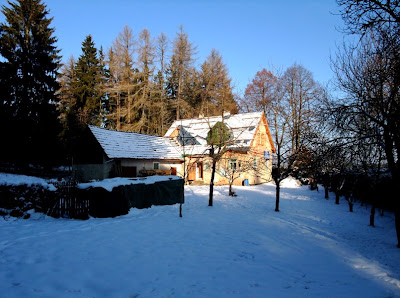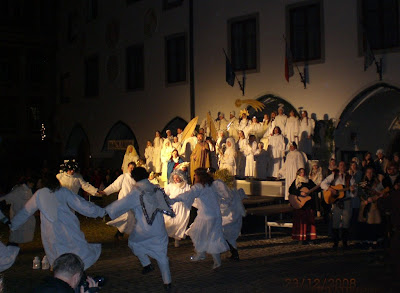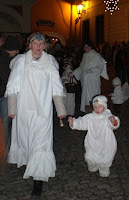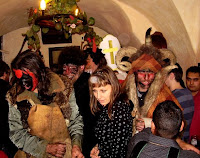
Wishing you all good fortune in the New Year - Pushkin
A blog by Brits in Cesky Krumlov, South Bohemia, a UNESCO-listed jewel of a town in the Czech Republic. We love the place and we intend to share with you our experiences and our enthusiasm about the place, the people and the beautiful countryside.
 This evening Pushkin and I,
This evening Pushkin and I,  plus my visiting parents, went to the Town square where the residents perform their yearly Nativity. It's always a fantastic event, as it is completely un-official, un-sponsored, devised by our friends from the Mill but enjoyed by all, old and young alike.
plus my visiting parents, went to the Town square where the residents perform their yearly Nativity. It's always a fantastic event, as it is completely un-official, un-sponsored, devised by our friends from the Mill but enjoyed by all, old and young alike. playing carols, then angels dancing and prancing - the most delicious are the little children of course, but the odd beer-bellied dad is also something to behold! There follows a more solemn procession with Mary and Joseph with a (proper live) baby, and more carols and dancing. Last in are the Three Kings on horses - provided by our friends of the Pohoda stable.
playing carols, then angels dancing and prancing - the most delicious are the little children of course, but the odd beer-bellied dad is also something to behold! There follows a more solemn procession with Mary and Joseph with a (proper live) baby, and more carols and dancing. Last in are the Three Kings on horses - provided by our friends of the Pohoda stable.  The shepherds settle by a roaring campfire, the carols are cheerfully joined in by the whole audience. The last, most solemn, carol - a Czech 'Onto us the Christ is born' is sung in all seriousness by everyone on the square upon which the little angels all go round with plates and baskets of biscuits (baked at the Mill) and little jars with candles,
The shepherds settle by a roaring campfire, the carols are cheerfully joined in by the whole audience. The last, most solemn, carol - a Czech 'Onto us the Christ is born' is sung in all seriousness by everyone on the square upon which the little angels all go round with plates and baskets of biscuits (baked at the Mill) and little jars with candles,  handing them to the audience as presents.
handing them to the audience as presents.
 I'm no expert on the subject, but find it fascinating to compare traditions so here are some for those who might also be interested:
I'm no expert on the subject, but find it fascinating to compare traditions so here are some for those who might also be interested:


 I've pinched these two images off Google because, alas, I just don't have the patience to make any of these - but I thought they should go on the blog because these 'Vizovice' figures are very typical of Moravian, folksy, tree-decorations, and unusual in that they are made from dough.
I've pinched these two images off Google because, alas, I just don't have the patience to make any of these - but I thought they should go on the blog because these 'Vizovice' figures are very typical of Moravian, folksy, tree-decorations, and unusual in that they are made from dough.
 Following on from my post below:
Following on from my post below: The family rituals go something like this: a half-eager, half-terrified child is thinking of nothing else all day, and when evening falls, there's a bell and in comes the figure of the Saint with his retinue of angel(s) and devil(s). 'Have you been a good girl (boy)????', asks the Saint, while the devil rattles his chains threateningly with all sorts of grunts and much impatience. The angel meanwhile looks on the child beningly. This opposition of course represents us all, with St Nicholas being the figure of understanding and forgiveness that balances the opposites. He keeps the devil in check, and when the child has admitted to some small trespasses and told proudly of his achievements, when he has sung a song or recited a poem the three leave a small present - perhaps a bar of chocolate and a tangerine, but always also a piece of coal from the devil - and leave, promising to come back next year.
The family rituals go something like this: a half-eager, half-terrified child is thinking of nothing else all day, and when evening falls, there's a bell and in comes the figure of the Saint with his retinue of angel(s) and devil(s). 'Have you been a good girl (boy)????', asks the Saint, while the devil rattles his chains threateningly with all sorts of grunts and much impatience. The angel meanwhile looks on the child beningly. This opposition of course represents us all, with St Nicholas being the figure of understanding and forgiveness that balances the opposites. He keeps the devil in check, and when the child has admitted to some small trespasses and told proudly of his achievements, when he has sung a song or recited a poem the three leave a small present - perhaps a bar of chocolate and a tangerine, but always also a piece of coal from the devil - and leave, promising to come back next year.
 Tonight was the St Nicholas eve celebration -
Tonight was the St Nicholas eve celebration -  eat your heart out Halloween, the Czechs have their own tradition which features the coming of St Nicholas with his devil and his angel. A night much looked forward to by the children here: though for the little ones it is a night of trepidation and excitement mixed, as St Nicholas comes bearing presents if you were good during the past year, but then there's also the devil to threaten you if you weren't! Lucky the angel's there to keep the devil from getting too dangerous!
eat your heart out Halloween, the Czechs have their own tradition which features the coming of St Nicholas with his devil and his angel. A night much looked forward to by the children here: though for the little ones it is a night of trepidation and excitement mixed, as St Nicholas comes bearing presents if you were good during the past year, but then there's also the devil to threaten you if you weren't! Lucky the angel's there to keep the devil from getting too dangerous!

 'civilians' mingle by the bar with the heavenly characters.
'civilians' mingle by the bar with the heavenly characters.
 (no, this is not us :-)
(no, this is not us :-)